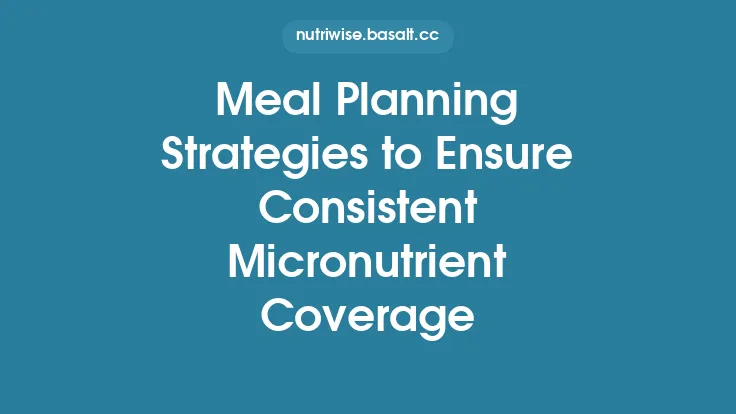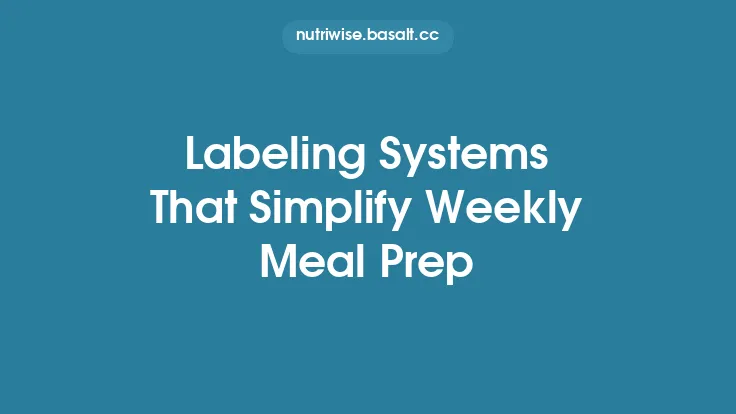When it comes to feeding yourself or a family without constantly watching the bottom line, the secret isn’t a magic grocery coupon or a one‑time diet fad—it’s a well‑structured weekly meal plan that aligns with your financial reality, cooking habits, and nutritional goals. A cost‑effective plan does more than just keep receipts low; it reduces decision fatigue, minimizes impulse purchases, and creates a predictable rhythm that makes healthy eating feel effortless rather than forced. Below is a step‑by‑step guide to building a weekly menu that stays within budget and, more importantly, stays on the table.
Assessing Your Budget and Food Priorities
- Set a Realistic Food Budget
- Start by reviewing your monthly expenses and decide what portion you can allocate to groceries. A common benchmark is 10‚Äë15‚ÄØ% of net income, but the exact figure should reflect your personal circumstances.
- Break this monthly amount into a weekly target. For example, a $400 monthly grocery budget translates to roughly $100 per week.
- Identify Nutritional Priorities
- List any dietary requirements (e.g., higher protein, low sodium, vegetarian).
- Rank these priorities so you know where you can be flexible (e.g., you might accept a slightly lower protein day if it saves $2).
- Factor in Non‚ÄëFood Costs
- Include occasional kitchen supplies (trash bags, dish soap) in your weekly estimate. These small items can add up and affect the true cost of a meal plan.
Inventory Audit: Knowing What You Already Have
Before you write a single line on a shopping list, take a systematic inventory of your pantry, fridge, and freezer:
| Category | Typical Items | Quantity | Expiration Check |
|---|---|---|---|
| Grains & Pasta | Rice, quinoa, spaghetti | 2‚ÄØkg, 1‚ÄØkg, 500‚ÄØg | ‚úî |
| Canned Goods | Beans, tomatoes, broth | 6 cans each | ‚úî |
| Proteins | Eggs, canned tuna, tofu | 12‚ÄØpcs, 4 cans, 2 blocks | ‚úî |
| Dairy & Alternatives | Milk, yogurt, cheese | 2‚ÄØL, 4‚ÄØcups, 300‚ÄØg | ‚úî |
| Fresh Produce | Carrots, onions, potatoes | 1‚ÄØkg each | ‚úî |
Mark any items that are close to expiration; they become natural candidates for inclusion in the upcoming week’s menu, reducing waste without compromising cost.
Defining Your Meal Framework
A clear framework prevents the plan from becoming a free‑form list that’s hard to follow.
| Decision | Guideline |
|---|---|
| Number of Meals per Day | Decide if you’ll prepare three full meals, or if you’ll incorporate snacks. |
| Cooking Skill Level | Choose recipes that match your comfort zone; complex techniques often require extra ingredients. |
| Time Availability | Allocate a realistic amount of cooking time per day (e.g., 30‚ÄØmin on weekdays, 60‚ÄØmin on weekends). |
| Portion Size | Standardize portions (e.g., 1‚ÄØcup cooked grain, ¬Ω‚ÄØcup protein) to simplify cost calculations. |
Document these parameters in a simple table; they become the scaffolding for every menu decision.
Selecting Versatile Core Ingredients
Core ingredients are the workhorses that appear in multiple meals, stretching your budget further.
| Ingredient | Why It’s Cost‑Effective | Typical Uses |
|---|---|---|
| Rice (white or brown) | Low per‚Äëserving cost, long shelf life | Stir‚Äëfries, grain bowls, soups |
| Dried Beans/Lentils | High protein, inexpensive when bought dry | Chili, salads, stews |
| Eggs | Complete protein, cheap per unit | Scrambles, frittatas, binding for patties |
| Canned Tomatoes | Shelf‚Äëstable, adds flavor | Sauces, soups, braises |
| Onions & Garlic | Base aromatics, low cost | Almost every savory dish |
| Frozen Vegetables | Consistent price, minimal waste | Side dishes, mixed stir‚Äëfries |
| Pasta | Quick cooking, inexpensive | One‚Äëpot meals, salads |
By rotating these staples across meals, you keep the grocery list short and the cost per plate low.
Calculating Cost per Serving
Understanding the true cost of a recipe prevents hidden expenses.
- List All Ingredients with Unit Prices
- Example: 1‚ÄØkg rice @ $1.20/kg, 1‚ÄØcan beans @ $0.80/can.
- Determine Quantity Used per Recipe
- If a recipe calls for 200 g rice, the cost contribution is (200 g ÷ 1000 g) × $1.20 = $0.24.
- Sum Ingredient Costs
- Add the cost of each component, including spices (usually negligible per serving).
- Divide by Number of Servings
- If the total cost is $4.80 for 4 servings, the cost per serving is $1.20.
Create a simple spreadsheet with columns for *Ingredient, Unit Price, Quantity Used, Cost Contribution, and Total Cost*. This sheet becomes a reusable tool for future recipes.
Building the Weekly Menu
With budget, inventory, framework, core ingredients, and cost calculations in hand, you can now assemble the menu.
- Start with Core Ingredient Slots
- Assign rice, pasta, or beans to at least three meals. This guarantees a low‚Äëcost base.
- Layer Protein and Vegetables
- Pair each core slot with a protein (e.g., eggs, canned tuna) and a vegetable (fresh or frozen).
- Balance Flavor Profiles
- Alternate between cuisines or seasoning styles (e.g., Mexican‚Äëinspired beans one night, Italian‚Äëstyle tomato sauce another) to keep meals interesting without adding new ingredients.
- Check Total Weekly Cost
- Add up the per‚Äëserving costs for each planned meal. If the sum exceeds your weekly budget, revisit the menu and replace the most expensive item with a cheaper alternative (e.g., swap a specialty cheese for a modest shredded mozzarella).
- Finalize the Schedule
- Write the meals into a calendar format (Monday: Stir‚Äëfried rice with veggies; Tuesday: Lentil soup; etc.). This visual layout helps you see variety and spot any accidental repetitions.
Creating a Structured Shopping List
A well‚Äëorganized list translates the menu into a smooth checkout experience.
- Group by Store Section
- Produce, grains, canned goods, dairy, frozen, etc. This reduces back‚Äëand‚Äëforth trips inside the store.
- Specify Quantities
- Instead of “rice,” write “1 kg white rice.” Precise amounts prevent over‑purchasing.
- Include “Use‑First” Items
- Mark items you already have that need to be used soon (e.g., “use 2 cans of beans – check expiration”). This keeps inventory turnover high.
- Add a “Buffer” Column
- Allocate a small margin (e.g., $5) for unexpected price changes or missing pantry staples. This buffer protects the weekly budget from minor fluctuations.
Scheduling Cooking and Prep Time
Even the most economical menu fails if it doesn’t fit into real life.
| Day | Meal | Prep Time | Cook Time | Total Time | Notes |
|---|---|---|---|---|---|
| Mon | Rice & Veggie Stir‚Äëfry | 5‚ÄØmin (chop) | 15‚ÄØmin | 20‚ÄØmin | Quick weekday dinner |
| Tue | Lentil Soup | 10‚ÄØmin (rinse) | 30‚ÄØmin | 40‚ÄØmin | Can simmer while you work |
| Wed | Egg & Veggie Frittata | 5‚ÄØmin (mix) | 20‚ÄØmin | 25‚ÄØmin | Use leftover veggies |
| Thu | Pasta with Tomato‚ÄëBean Sauce | 5‚ÄØmin (dice) | 20‚ÄØmin | 25‚ÄØmin | One‚Äëpot convenience |
| Fri | Tuna & Rice Bowl | 5‚ÄØmin (assemble) | 0‚ÄØmin | 5‚ÄØmin | No‚Äëcook assembly |
Identify “anchor” meals that require minimal active cooking (e.g., assembly bowls) for the busiest days, and allocate longer, more involved recipes to evenings when you have more time.
Monitoring and Adjusting Your Plan
A static plan rarely stays optimal. Implement a feedback loop:
- Track Actual Spend
- Keep receipts and total the amount spent each week. Compare it to the projected budget.
- Log Meal Satisfaction
- Rate each meal on a simple 1‚Äë5 scale. Low scores may indicate a need for flavor tweaks or ingredient swaps.
- Identify Cost Drivers
- If a particular ingredient consistently pushes the budget over, consider alternatives (e.g., replace a specialty sauce with a basic herb blend).
- Iterate Monthly
- Every four weeks, review the data, adjust core ingredient quantities, and refine the cost‚Äëper‚Äëserving calculations. Over time, the plan becomes increasingly accurate and personalized.
Tools and Resources for Ongoing Success
While a pen and paper can do the job, a few digital aids streamline the process:
| Tool | Primary Benefit |
|---|---|
| Spreadsheet (Google Sheets / Excel) | Automatic cost calculations, easy duplication for future weeks. |
| Meal‚ÄëPlanning Apps (e.g., Mealime, Paprika) | Template menus, built‚Äëin grocery list generation, portion scaling. |
| Unit‚ÄëPrice Calculator Websites | Quickly convert package prices to per‚Äëounce or per‚Äëgram values. |
| Digital Pantry Tracker | Log what you have, set expiration alerts, and generate “use‑first” suggestions. |
| Budget‚ÄëTracking Apps (e.g., Mint, YNAB) | Consolidate grocery spend with other household expenses for a holistic view. |
Choose the tool that matches your comfort level; the key is consistency—regularly updating the system ensures the plan remains both affordable and enjoyable.
Bringing It All Together
A cost‚Äëeffective weekly meal plan is less about cutting corners and more about constructing a repeatable system that respects your financial limits while delivering variety and nutrition. By:
- Setting a clear budget
- Auditing existing food supplies
- Defining a realistic meal framework
- Choosing versatile core ingredients
- Calculating true per‚Äëserving costs
- Mapping a balanced weekly menu
- Generating a precise shopping list
- Aligning cooking time with daily schedules
- Monitoring spend and satisfaction
- Leveraging simple digital tools
you create a self‑reinforcing loop where each week becomes easier, cheaper, and more satisfying than the last. The result isn’t just a handful of meals that fit a spreadsheet—it’s a sustainable habit that keeps both your pantry and your wallet full.





